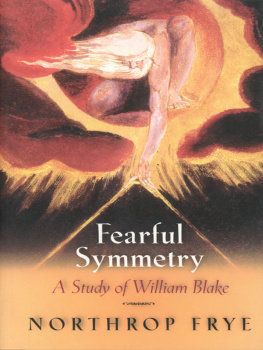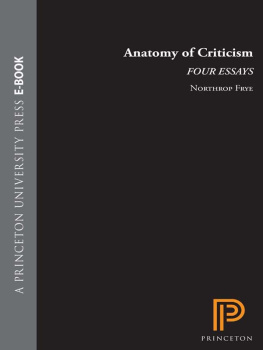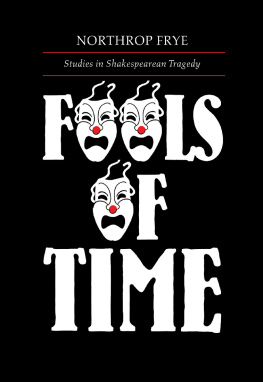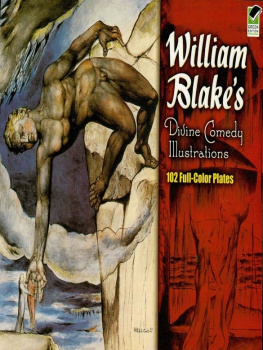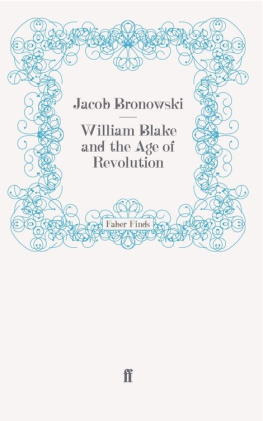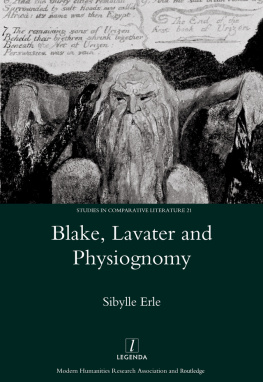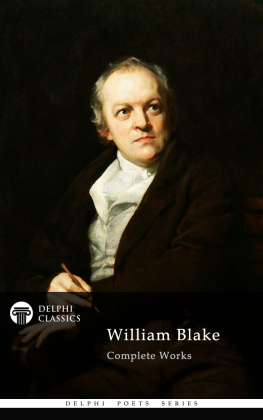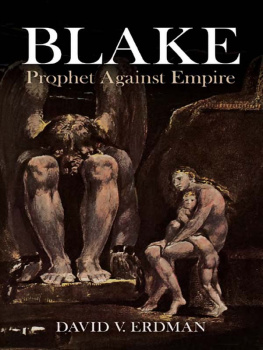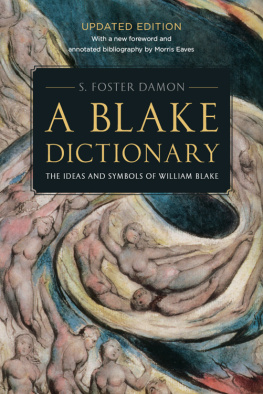
FEARFUL SYMMETRY
A STUDY OF WILLIAM BLAKE
FEARFUL SYMMETRY
A STUDY OF WILLIAM BLAKE
BY NORTHROP FRYE
PRINCETON UNIVERSITY PRESS
COPYRIGHT 1947 BY PRINCETON UNIVERSITY PRESS
PREFACE COPYRIGHT 1969 BY PRINCETON UNIVERSITY PRESS
ALL RIGHTS RESERVED
Library of Congress Catalog Card Number: 47-30296
ISBN 0-691-01291-1 (paperback edn.)
ISBN 0-691-06165-3 (hardcover edn.)
FIRST PRINCETON PAPERBACK EDITION, 1969
FOURTH PRINTING, 1974
PRINTED IN THE UNITED STATES OF AMERICA BY
PRINCETON UNIVERSITY PRESS AT PRINCETON, NEW JERSEY
This book is sold subject to the condition that it shall not, by way of trade, be lent, resold, hired out, or otherwise disposed of without the publishers consent, in any form of binding or cover other than that in which it is published.
TO
DR. PELHAM EDGAR
PREFACE
FEARFUL SYMMETRY was a hard book to write, not only because it was my first, and not only because of its subject. Every major poet demands from his critic a combination of direction and perspective, of intensive and extensive reading. The critic must know his poets text to the point of possession, of having it all in his head at once, as well as knowing whatever aspect of the poets background is relevant to his approach. At the same time he should be able to place his poet in a broad literary context. The doctoral thesis is useful for encouraging intensive reading, but of very little use for gaining literary perspective, which takes years to develop and cannot be hurried. The present book never went through the thesis stage, and my interest in Blake had from the beginning been of the extensive kind. Its fifth and last complete rewriting consisted largely of cutting out of it a mass of critical principles and observations, some of which found their way into my next long book, Anatomy of Criticism. This may explain why Fearful Symmetry takes the form, not of the fully documented commentary which is what I should prefer to write now, but of an extended critical essay in the Swinburne tradition. The subject of that essay is Blake in his literary context, which means, not Blakes place in literature, but Blake as an illustration of the poetic process.
In the early stages I felt all the resistance against grappling with a specific symbolic language, which has to be got up like so much Gothic, in Professor Douglas Bushs words, that so many other critics of Blake had felt. If Blake were unique, or even rare, in demanding this kind of preparation, I should perhaps not have finished the book. But there are so many symbolic constructs in literature, ranging from Dantes Ptolemaic universe to Yeatss spirit-dictated Vision, that one begins to suspect that such constructs have something to do with the way poetry is written. For readers brought up to ask only emotional reverberation or realistic detail from poetry, it comes as a disillusioning shock to learn that, as Valry says, cosmology is a literary art. The statement of Los in Jerusalem: I must Create a System, or be enslavd by another Mans has been quoted out of context by many critics, including myself on occasion. We should take it in its context, not identifying the I with Blake, but seeing it as defining a necessary activity of the poetic process. One should never think of Blake as operating or manipulating a system of thought, nor should we be misled by his architectural metaphors to think of his symbolic language as something solidified and crustacean. Part of the context of Loss remark is this:
Striving with Systems to deliver Individuals from those Systems;
That whenever any Spectre began to devour the Dead,
He might feel the pain as if a man gnawd his own tender nerves.
Cosmology is a literary art, but there are two kinds of cosmology, the kind designed to understand the world as it is, and the kind designed to transform it into the form of human desire. Platonists and occultists deal with the former kind, which after Newtons time, according to Blake, became the accepted form of science. Cosmology of this type is speculative, which, as the etymology of that word shows, is ultimately intellectual narcism, staring into nature as the mirror of our ordinary selves. What the mirror shows us is what Blake calls mathematic form, the automatic and mindless universe that has no beginning nor end, no up nor down. What such a universe suggests to us is resignation, acceptance of what is, approval of what is predictable, fear of whatever is unpredictable. Blakes cosmology, of which the symbol is Ezekiels vision of the chariot of God with its wheels within wheels, is a revolutionary vision of the universe transformed by the creative imagination into a human shape. This cosmology is not speculative but concerned, not reactionary but revolutionary, not a vision of things as they are ordered but of things as they could be ordered. Blake is often associated with speculative cosmologists, but the psychological contrast with them is more significant than any resemblances. Blake belongs with the poets, with the Milton whose Raphael advised Adam that while studying the stars was all very well, keeping his own freedom of will was even more important. Blakes poetry, like that of every poet who knows what he is doing, is mythical, for myth is the language of concern: it is cosmology in movement, a living form and not a mathematical one. The Word is what gives movement to number, as Yeats says.
There is a broad consistency in Blakes mythology: there are some uncertain points, such as the role of Los in Europe, but on the whole he meant the same things by Orc and Urizen and Enitharmon all through his poetic life. The combination of radical and evangelical sympathiesso frequent in England, so rare elsewhereremained with him to the end. He hailed with delight the apocalyptic element in the American and French revolutions, the glimpse of eternal freedom that they gave. But he also saw growing, in France and England alike, a Deism or self-righteous mob rule, two mobs which most hated, not each other, but the sane voice of prophecy telling them how much of what they were doing, in war and peace alike, was futile and stupid and wrong. In his earlier work Blake thought of the essential Mental fight of human life as the revolt of desire and energy against repression, though even then he was careful to say that reason was the form of desire and energy, which are never amorphous except when they are repressed. Later he tended more to see this conflict as one of the genuine reason, or what he called intellect, against rationalization. The tygers of wrath are wiser than the horses of instruction, but Blake thought of his own poetry as instructive, and the horses of instruction in their turn are wiser than the balky mules of hysteria.
Blake wrote during the Napoleonic Wars, in one of
the central Cities of the Nations
Where Human Thought is crushd beneath the iron hand of Power.
I wrote Fearful Symmetry during the Second World War, and hideous as that time was, it provided some parallels with Blakes time which were useful for understanding Blakes attitude to the world. Today, now that reactionary and radical forces alike are once more in the grip of the nihilistic psychosis that Blake described so powerfully in Jerusalem, one of the most hopeful signs is the immensely increased sense of the urgency and immediacy of what Blake had to say.
NORTHROP FRYE
Toronto, Canada
March 1969
CONTENTS
ILLUSTRATIONS
(following page 50)
PART ONE
THE ARGUMENT
GON. How lush and lusty the grass looks! how green!
Next page
